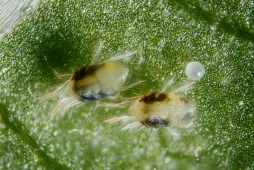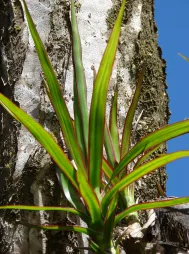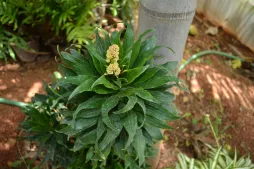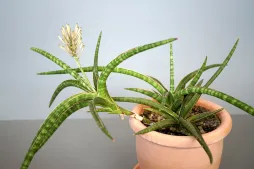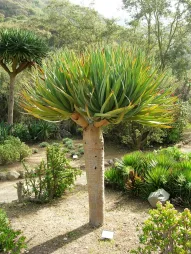Dracaena braunii, false bamboo
Dracaena braunii, also known as Dracaena sanderiana or lucky bamboo, belongs to the Asparagaceae family. It grows in the tropical forests of Cameroon and Gabon.
How to recognize Dracaena braunii?
Dracaena sanderiana is a rhizomatous plant growing two to three meters high. In pots, it grows to no more than 1.5 meters.
Its slender, flexible green stems are streaked with cream-colored rings. The leaves share the same color: green with creamy variegation. Oval and pointed, they are lance-shaped. They measure between seven and 25 centimetres long and from 1.5 to four centimetres wide.
In its natural habitat, Dracaena braunii blooms all year round except in winter, but this is very rare indoors. Clusters of white flowers tinged with purple may appear. Lucky bamboo can also produce black berries.
Unlike the Dragon tree draco, Dracaena sanderiana is toxic to pets. Harmless to humans, it causes digestive problems in dogs and cats that ingest it.
Our maintenance tips
Plenty of sun, but without burning the leaves, regular watering, but without drowning the roots... Even if the plant is suitable for beginners, caring for your Dragonwood braunii requires rigor and moderation.
Watering
Dragonflies braunii like to keep their feet cool, but can't stand soggy soil. Water when the substrate is dry on the surface, for about three centimetres.
To provide your plant with the nutrients it needs, give preference to rainwater. Avoid tap water, which is often too hard. Finally, to avoid damaging the roots, use water at room temperature.
If you use a saucer or planter, remove any stagnant water. It could rot the root system.
Spray
To provide your Dracaena braunii with the necessary humidity, mist its foliage with non-calcareous water at room temperature. If filtered water is not available, you can collect rainwater and use it for misting.
Repotting
Every spring, repot your Dracaena braunii to give it more space.
In a pierced pot larger than the previous one, place a bed of clay balls, gravel or pebbles. Cover with the substrate. You can mix a special potting soil for green plants or houseplants with sand or compost.
Remove your plant from its container. To help the roots take hold, gently loosen the root bun. Plant in the center of the pot and top up with potting soil.
To improve humidity, place the pot on a dish filled with moist clay balls.
To improve humidity, place the pot on a dish filled with moist clay balls.
Cleaning
The dust that accumulates on the leaves prevents your Dragonwood braunii from receiving light. Remember to clean the foliage with a damp, clean cloth or sponge.
Prune
Remove dead leaves. If you use pruning shears or scissors, clean them beforehand to prevent the spread of disease.
Plantation
When the risk of frost has passed, it's time to plant.
Dragonflies braunii tolerate mild winters. If you live in the south of France or by the sea, you can plant them in the ground.
Choose a bright location, but without direct sunlight. Make sure the soil is well drained. If the soil in your garden is heavy or retains moisture, plant them at the top of a mound or on a slope.
After loosening the soil, dig a hole three times the size of your Dragonwood brauniipot. Place a layer of clay balls or gravel and transplant. Fill in with a mixture of ordinary soil and sand, or even potting soil for citrus and Mediterranean plants.
Protect the base with a mineral mulch (pebbles, gravel, pebbles, slate, etc.) before watering abundantly.
Cutting
Cutting is carried out during the strong growth phase, generally in spring and early summer.
Select a stem without flowers or flower buds. Using clean pruning shears, cut a fifteen-centimeter section.
Slash the base vertically with a disinfected cutter to increase the rooting surface. You can dip this end in cuttings hormone.
Remove the lower leaves and keep only the terminal pair.
Prepare a pierced pot with a bed of clay balls at the bottom for drainage. Pour in a mixture of sand and potting soil. Preferably use a horticultural or seedling potting soil, as these are rich in nutrients. Plant your graft in this pot.
Place your cutting in a bright spot away from direct sunlight and water.
Diseases / Threats
Information
| Family | Asparagaceae - Asparagaceae |
| Type | Dracaena - Dracaena |
| Species | Dracaena braunii - Dracaena braunii |
| Lifecycle | Perennial |
| Foliage | Evergreen |
| Exposures | |
| Substrats | |
| Planting methods |
Open ground In pots In tubs Planter |
| Categories | |
| Tags |
Beginner Toxic |
| Origin |
Central Africa |
| Hardiness (USDA) | 12b |
| Leaf color |
|
| Flower color |
|
| Fruit color |
|
Discover plants from the same family













